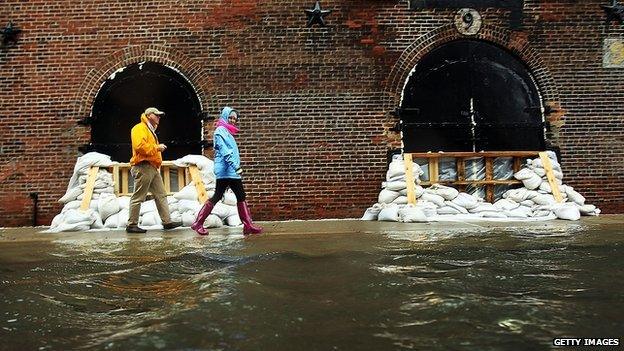Climate change impacts and adaptation
- Published

Climate change will continue even if emissions are stabilised, making adaptation vital
The UN's climate panel has published the second part of its long-awaited report. The document by the Intergovernmental Panel on Climate Change (IPCC) considered the impacts of a warming world, vulnerabilities in human and natural systems and the potential for adaptation.

What are the big impacts of climate change?
Human-induced warming is likely to lead to large-scale and potentially irreversible changes in physical systems such as the oceans and the cryosphere (regions covered by snow or ice).
Projections suggest an increase in extreme weather events, such as heavy rainfall, more intense storms and heat-waves.
Melting ice will contribute to sea level rise, with consequences for coastal communities, ecosystems and cities.
Ocean acidification is likely to have widespread effects in marine species, including the loss of coral communities.
For a more detailed overview of science behind these changes, read the Q&A on climate change.

How important is adaption?
Even if emissions of greenhouse gases were stabilised soon, climate change and its effects would continue for some time afterwards. This will require adaptation, particularly in developing countries, which are likely to be hit hardest, but also elsewhere.
For example, planning for sea-level increases remains a key challenge for governments of countries with vulnerable coastlines, including several with major cities at risk from rising waters.
New York, for example, unveiled a multi-billion-dollar plan to protect the city following Hurricane Sandy. But other urban centres are at greater risk, and are located in countries that have less money to spend on adaptation.


How could water resources be affected?
Future changes in freshwater availability are likely to affect sustainable development across the world.
Water supplies are likely to increase at higher latitudes and in parts of the wet tropics. But an increase in heavy rainfall in some of these regions is also likely to bring with it many negative effects, such as a raised risk of flooding and the waterlogging of soils.
Over mid-latitudes, and the dry tropics - where water supplies are already stressed - resources are likely to become even scarcer.
Sea-level rise could also adversely affect groundwater resources by leading to the intrusion of salt water into coastal aquifers.
The melting of small glaciers also poses problems. In the Andes, glacial melt water supports river flow and water supply for tens of millions of people during the long dry season.

And ecosystems?
Global warming can force species to move to higher latitudes and higher altitudes where temperatures are better for their chances of survival.
It can also cause changes to seasonal events in the life cycle of a species. These include migration and mating, in the case of animals, and blooming, in the case of plant species.
Mismatches in the timing of these events can lead to serious consequences.
For example, when migrating birds arrive either before or after food sources are present, it can negatively affect their growth and survival.

What about food supplies?
Crop yields are likely to increase at higher latitudes under some scenarios of global average temperature increase - and depending on the crop.
At lower latitudes, especially the seasonally dry tropics, crop yields are likely to fall - even for small temperature increases, increasing the risk of hunger.
The increased frequency of both droughts and floods is expected to adversely affect agricultural production.
Advances in plant science could help increase yields while at the same time reducing the use of fertiliser and pesticides - though the use of genetic modification to generate more suitable crop varieties remains controversial.
And other strategies such as modernising irrigation could help farmers make the most efficient use of water.
But some experts emphasise the importance of tackling food supply problems through societal approaches, such as influencing behaviour, consumption and expectations.

What type of health impacts can we expect?
Climate change is likely to affect the health of human populations in a variety of ways. Increased levels of malnutrition will have implications for children's growth and development.
People face a greater risk of death, disease and injury due to heat-waves, floods, storms, fires and droughts.
Other effects include an altered burden of water-borne diseases; an increased frequency of cardio-respiratory illness due to higher concentrations of ground level ozone, and the movement of some infectious disease carriers into new regions.
There might be some benefits, too: parasites such as malaria could also contract in some present parts of their range, and some regions might see a reduction in deaths from cold exposure.

What can industry expect?
The benefits and costs of climate change for industry, settlement, and society will vary widely by location and scale.
While there may be some positive effects in temperate and high-latitude regions, other parts of the world remain extremely vulnerable.
The most at-risk industries, settlements and societies are those in coastal and river floodplains, those whose economies are closely linked with climate-sensitive resources, and those in areas prone to extreme weather events, especially where rapid urbanisation is occurring.
Poor communities can be especially affected because they tend to be concentrated in relatively high-risk areas, have more limited coping capacities, and can be more dependent on climate-sensitive resources such as local water and food supplies.
- Published25 March 2014

- Published27 September 2013

